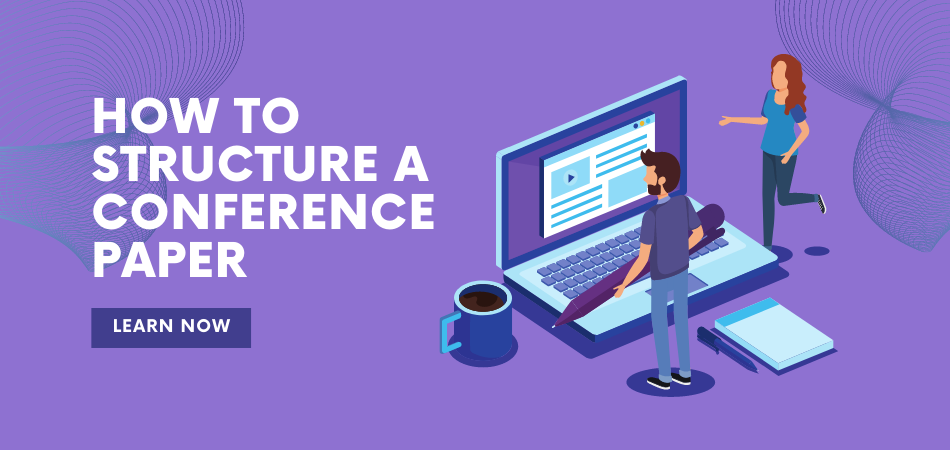Are you a researcher or academic preparing to present your work at a conference? If so, you may wonder, “How to structure a conference paper?” Crafting a well-organized conference paper is essential for effectively communicating your research findings to an audience of experts in your field.
Structuring a conference paper involves organizing your content effectively. From the introduction to the conclusion, each section plays a crucial role in conveying your research findings.
In this blog, we will explore the key elements that make up a successful conference paper structure. Let’s dive in and discover how to create an impactful conference paper!
Why Do You Need A Good Structured Conference Paper?
A well-structured conference paper is essential for effectively conveying research findings and maximizing the impact of your work. Here are the reasons why a good structure is crucial in conference papers:

Clarity and Coherence
A well-structured conference paper ensures clarity and coherence in presenting your research. By logically organizing your content, you help readers follow your arguments and understand the flow of your ideas. Clear and concise section headings and subheadings guide readers through the paper, making navigating and comprehending the content more accessible.
Engaging the Audience
A good structure captivates the audience’s attention and keeps them engaged throughout the paper that’s presented at a conference like Arts, Academics, and Humanities Conferences. A well-crafted introduction hooks the readers, while a properly structured body provides a coherent narrative. A clear and logical flow helps the audience follow your thoughts and focus on your key points. Engaging the audience enhances their understanding and makes your presentation memorable.
Highlighting Key Points
An effective structure allows you to emphasize the key points of your research. You can highlight the most important findings, arguments, and conclusions by organizing your content into sections and subsections. This helps the audience grasp the essence of your work and its significance. Effective use of headings and subheadings draws attention to crucial aspects, enabling readers to identify the main takeaways from your paper quickly.
Facilitating Peer Review
A well-structured conference paper facilitates the peer review process. Reviewers and assessors can easily navigate through your paper, evaluating the coherence of your arguments, the rigor of your methodology, and the validity of your conclusions. Clear section headings and subheadings help reviewers locate specific sections, making the review process more efficient. A well-structured paper increases the chances of receiving constructive feedback and improving the quality of your work.
Enhancing Professional Reputation
A good structure reflects positively on your professional reputation. Presenting your research clearly and organized demonstrates your attention to detail, professionalism, and commitment to effective communication. A well-structured conference paper showcases your expertise and increases the likelihood of being invited to present at conferences or collaborate with other researchers. It also enhances your credibility in the academic community, contributing to your overall professional standing.
How to Structure a Conference Paper?
When structuring a conference paper, an organized and coherent approach is crucial for effectively presenting your research. Below, we will explore key elements to consider when structuring your conference paper.
A Clear Objective
Start by clearly defining the objective of your conference paper. What do you aim to achieve or contribute through your research? This objective will serve as a guiding principle throughout the paper, helping you maintain focus and coherence. Avoid vague or broad objectives.
Instead, choose a specific, measurable goal that aligns with your research and the conference theme. A clear objective will help you stay on track and deliver a well-structured paper.
An Engaging Introduction
The introduction sets the stage for your conference paper and should capture the audience’s attention. Begin with a hook or a thought-provoking question related to your research topic. Provide relevant background information to establish context and highlight the significance of your study.
Clearly state the research problem or question you aim to address and outline your objectives. An engaging introduction will draw the audience in and create anticipation for your paper.
A Thorough Literature Review
A well-crafted literature review demonstrates your understanding of the existing research on your topic. Conduct a comprehensive review of relevant studies, theories, and methodologies. Summarize key findings, identify research gaps, and highlight the relevance of your study.
Organize your literature review thematically or chronologically, depending on what best suits your research. By providing a solid foundation of existing knowledge, your conference paper will contribute to the field and establish credibility.
Well-described Methodology and Data Collection
In this section, explain your study’s research design, methods, and procedures. Clearly describe the data collection process, including the participants or sample size, data sources, and ethical considerations.
Be concise yet thorough, allowing readers to understand the validity and reliability of your research. Address any limitations or challenges encountered and explain how you mitigated them. Transparently presenting your methodology ensures the reproducibility of your study.
Organized Findings and Analysis
Present your findings in a logical and structured manner. Clearly summarize the results and use appropriate visuals, such as graphs or tables, to enhance comprehension. Analyze and interpret the findings, relating them to your research question and objectives.
Discuss any unexpected or contradictory results and provide possible explanations. Support your analysis with references to existing literature and theories. By organizing your findings effectively, you enable readers to follow your thought process and understand the significance of your research.
How to Present a Published Paper at a Conference?
Presenting a published paper at a conference is an exciting opportunity to share your research findings with a wider audience. Here, we will explore the key steps to effectively present a published paper at a conference.
Prepare Your Conference Paper
To present a published paper at a conference, ensure that your paper is structured appropriately based on the conference guidelines. Follow the recommended format, including sections such as introduction, methodology, results, discussion, and conclusion. Adhere to the word limit specified by the conference organizers to ensure your presentation is concise and focused.
Adapt Your Paper for an Oral Presentation
To make your paper readable and engaging during the presentation, modify it to “read like a talk.” Use shorter sentences and simpler language to maintain the audience’s attention and comprehension. Highlight key points and emphasize the significance of your findings. Incorporate visuals, such as graphs or images, to support your presentation and aid understanding.
Practice and Time Your Presentation
Rehearse your presentation multiple times to become comfortable with the material and ensure a smooth delivery. Time yourself to stay within the allocated presentation slot, typically 15-20 minutes. Practice transitioning between slides and maintaining a steady pace. Consider recording yourself to identify areas for improvement and enhance your speaking skills.
Engage with the Audience
Make eye contact with the audience during your presentation and speak clearly and confidently. Use non-verbal cues, such as hand gestures, to enhance your message. Encourage questions and interaction from the audience, fostering a dynamic exchange of ideas. Be prepared to address potential queries and engage in discussions about your research.
Follow-Up and Networking
After your presentation, take the opportunity to network with fellow researchers and attendees. Attend other sessions and engage in discussions to broaden your knowledge and establish professional connections. Consider adding your conference paper to platforms like Google Scholar and LinkedIn to increase its visibility and potential impact.
Difference Between Journal and Conference Papers
Journal and conference papers differ in their publication format and purpose. Journal papers are published in scholarly journals, undergo rigorous peer review, and have a longer publication timeline. They aim to contribute to the existing body of knowledge in a specific field.
In contrast, conference papers are typically presented at academic conferences and have a shorter publication timeline. They are often reviewed by a program committee and focus on presenting research findings or innovative ideas to a specialized audience.
While both types of papers are important for academic discourse, journal papers have a greater emphasis on comprehensive research and provide more detailed analysis, while conference papers allow for rapid dissemination of research and encourage discussions and collaborations among researchers.
How Long Should a Conference Paper Be?
A conference paper typically ranges from 6 to 10 pages, excluding references and appendices. The length should be around 3000 to 5000 words, depending on the conference’s guidelines.
However, some conferences may specify shorter or longer paper lengths. Adhere to these guidelines to ensure your paper is considered for acceptance. Remember, concise and clear writing is key to effectively conveying your research within the given word limit.
Some Common Mistakes To Avoid When Structuring A Conference Paper
While understanding how to structure a conference paper is crucial, it’s equally important to be aware of common mistakes to avoid. By recognizing these pitfalls, you can enhance the effectiveness of your paper and ensure a successful presentation.
- Lack of Clarity in Objectives: Failing to clearly articulate your research objectives can confuse the audience and weaken the paper’s focus. Clearly state your objectives and align them with the overall purpose of your study.
- Poor Organization and Flow: A disorganized paper lacking logical flow can hinder comprehension. Structure your paper coherently, using clear headings, subheadings, and transitions to guide the reader smoothly through your content.
- Insufficient Background Information: Skipping over important background information can leave the audience confused about the context of your research. Provide sufficient background details to help the readers understand the significance of your study.
- Overwhelming Data Presentation: Presenting excessive data without proper analysis or interpretation can overwhelm the audience. Select the most relevant and significant data points and explain their implications concisely.
- Neglecting the Literature Review: Failing to conduct a comprehensive literature review can result in overlooking important studies or research gaps. Review the existing literature to situate your work within the broader academic landscape.
- Lack of Cohesion Between Sections: Each section of your paper should flow seamlessly into the next, with clear connections between them. Avoid abrupt transitions or disjointed content that may confuse or disengage the audience.
- Inadequate Conclusion: A weak or abrupt conclusion can leave the audience unsatisfied and diminish the impact of your paper. Summarize the main findings, reiterate the significance of your research, and provide suggestions for future studies.
Final Notes
Understanding how to structure a conference paper is essential for researchers and academics seeking to share their work effectively. By following a well-defined structure and organization, you can enhance the clarity and impact of your paper.
Start with a compelling abstract and introduction, present a coherent methodology and results, engage in a thoughtful discussion, and conclude with key takeaways. Remember to adhere to the conference’s guidelines regarding length and formatting.
By carefully structuring your conference paper, you can present your research concisely and engagingly, increasing its chances of being accepted and appreciated by the academic community.







